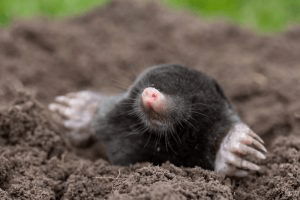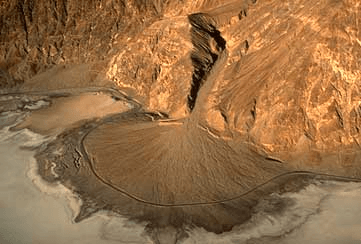What is weathering?
The breaking down of rock into smaller pieces.
What are the 4 different types of erosion?
Wind, water, gravity, ice.
What is the definition of deposition?
Deposition is the geological process in which sediments, soil and rocks are added to a landform or land mass.
What is the most nutrient filled horizon of soil called?
What is humus.
Glacial Erosion
What are the two types of weathering?
mechanical and chemical
What is the strongest form of erosion?
What is water
What are the primary agents of deposition?
Water, wind, ice, and gravity.
What are the layers of soil called?
What are horizons.

Physical Weathering by Abrasion
What is the name of the chemical weathering that involves oxygen and iron?
Oxidation
What is erosion?
Erosion is the process by which sediment and other materials are moved from one place to another.
What is one form of wind deposition?
Sand dunes.
What is the order in size of the 3 main particles, aside from humus, found in soil? (smallest to largest)
Clay, silt, and sand.
Rockfall Erosion by Gravity
What form of chemical weathering comes from the pollution create by humans?
Acid Precipitation
What does erosion cause streams to do?
They cause streams to widen and deepen
What does deposition do to the environment?
It builds up things from the sediment that is relocated there.
Does soil help plants in any way?
Yes, they give plants nutrients and a place to anchor roots for support and water absorption.

Mechanical weathering by Animal Action(Burrowing)
Name an agent of physical weathering that splits rock apart.
Root pry or ice wedging.
What kind of land form does erosion by running water create?
V-shaped valley.
This is often created because of wind deposition in a desert or beach.
sand dune
How would you describe the three main soil horizons?
A is topsoil consisting of humus, B is subsoil consisting of mostly sand and silt, and C is weathered rock and clay.
Sandstone Arch Erosion by Wind
What are lichens and what do they do?
Type of plant that grows on rock and they chemically break down rock to create soil.
Name a mass movement that may occur after very heavy rains.
Mudflow
If a VERY LARGE rock is found in the middle of a park in New York, what might have deposited it there?
Glacier
How is soil formed?
It is formed from the weathering of bedrock from below and organic materials from above.

Mass Movement(Creep) Erosion by Gravity
What does hydrolysis do and involve?
It involves water chemically breaking down and changing rock.
Caves, sea arches, and sea stacks are the result of what?
Erosion by wave action.
What can a longshore current create?
A beach, sandbars, a barrier island. (any of these)
What is the difference between a dirt mover and decomposer(give an example for each)?
A dirt mover exposes the soil like a prairie dog and a decomposer breaks it down like an earthworm.

Barrier Island Deposition by Water
What type of region would experience the most chemical weathering and which would experience the most physical?
chemical-warm and wet/physical-cold and wet
What are the two key ingredients to make a mass movement to occur?
Gravity and water.
Is deposition related to erosion, if so how?
Yes, because it follows erosion when energy is lost or friction is too strong.
Make a comparison of these three soil samples(Georgia, Florida, and Pennsylvania).
GA=clay, FL=sandy, and PA=loamy(or sand, silt, and clay)
Dust Storm Erosion by Wind
What would be the difference between rock physically weathered by wind and water?
Water would be smooth and rounded, whereas, wind would be more pitted and angular
A U-shaped valley is evidence of what?
An alpine glacier.
In a cave, these are formations of deposition.
Stalagmite, stalactite, column.
Does the type of soil vary depending on your position, if so how?
Yes, it can be different colors, different thickness, or different composition.

Alluvial Fan Deposition by Running Water
Stone Mountain experiences this type of physical weathering due to heat expansion of its Granite.
Exfoliation
Which erosional force can have the most features for and give at least two of them.
Glaciers-kettle lakes, moraines, striations, etc.
Name given to rock and debris found at the bottom of a hillside or mountain after a rockfall.
Talus
Name and describe two ways to conserve the soil.
(any of these-erosional barriers, composting, crop rotating, no-till farming, contour plowing, etc)

Chemical Weathering Oxidation